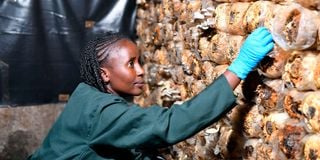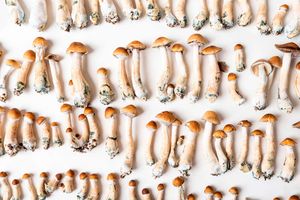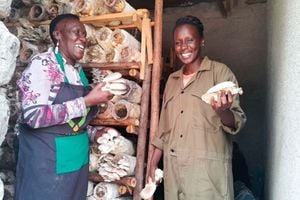
Julian Waithera grows both the Grey Oyster Mushrooms and the White Oyster mushroom.
Julian Waithera has been practising mushroom farming in Wangige, Kiambu, for sometime after realising it can be grown throughout the year.
The mushroom is grown in a 15 by 20ft house. She has named her enterprise Shamba Ndogo.
“I realised I could make money from mushroom. The good thing is that mushrooms do not require large tracts of land, unlike maize, beans, potatoes, vegetables and fruits,” Waithera says.
She grows the grey and white oyster mushrooms. She settled on the two types of mushroom after online research and getting information from other mushroom growers. Grey and white oyster mushroom growing does not need huge capital. The two varieties are also “survivors”.
“The environment for growing mushrooms is unique. Being new in this, I was advised to start with the oysters before trying other varieties,” Waithera says.
She converted her chicken coop to a mushroom growing house to save on costs.
“We also modified the structure to meet the conditions required for mushroom production,” Waithera says, adding that she was determined to have good yields.
She says mushrooms require low temperature, humidity and aeration.
Because mushrooms are grown indoors, many farmers opt for mud-walled houses. Waithera, however, says one can use any material and make modifications.

Julian Waithera who has been practicing mushroom farming in Lower Kabete, Wangige after realising that the high value crops can be grown all year round.
There are guidelines one must adhere to in the production of mushrooms – from preparation of the growing area to purchase of raw materials like substrates, supplements and spawn (seed).
“We were trained on mushroom spawn preparation at the farm to reduce the production cost,” she says.
There are several ways of preparing substrates but Waithera prefers using cotton husks as they are rich in nutrients, retain water, are good at mycelium colonisation and their risk of contamination is low.
The preparation involves soaking and sterilising the substrate by steaming the bags for four to six hours to kill unwanted microbes and fungi.
Inoculation (spawning) and incubation of the substrate for 14 to 28 days follows for the mycelium to colonise. This is followed by the fruiting stage, where the farmer should ensure the environment is ideal for good yields.
The last stage is harvesting. It entails twisting and pulling the mushroom from the growing area and packaging it for the market.
Waithera says failing to maintain high hygienic standards could exposing the mushroom to contaminants, leading to poor harvests.
According to the Shamba Ndogo proprietor, mushrooms do not require manure. They are largely considered organic as they utilise natural substrates with no chemicals, fertiliser or pesticides.
Spawning to the incubation stage for the mycelium to colonise the substrate takes 10 to 21 days. The mushrooms then begin to fruit.
In determining the maturity and readiness of the mushroom, Waithera looks at the size and shape. The edges of the mushroom should be flattened out but still not completely flat.

maturing mushrooms at Shamba Ndogo.
The other indicator is when the mushrooms start releasing spores. This shows the mushroom is tender and has flavour.
Most of Waithera’s clients are online, with traffic mainly on TikTok and YouTube.
“We also sell fresh mushrooms to grocery stores and online platforms like Tushop. Neighbours, friends and family come for Shamba Ndogo mushrooms,” she says.
For more profits, Waithera has begun adding value to her harvests. Dried mushrooms fetch more money.
“We recently discovered grinding the dried mushrooms and selling the powder. Shamba Ndogo has also started making mushrooms growing kits for sale. One can get the gadgets and grow mushrooms at home. Those who want to venture into mushroom growing and selling also come for the kits,” she says.
To save on cost, Shamba Ndogo produces and sells oyster mushroom spawn. Waithera also re-uses the waste, converting it to substrate and compost manure for her vegetable plot.
The venture has its share of challenges too. Waithera says mushrooms can be attacked by moulds, bacteria and other fungi. One needs to be wary of insects, snails, rats, worms and other pests.
“The market should be consistent since mushrooms are highly perishable,” Waithera says.
Mushroom production is labour intensive, with packaging and pasteurisation consuming time. The most common pasteurisation method used by small-scale mushroom farmers is firewood.
Waithera says little knowledge on mushroom production, especially in the initial stages, can lead to wastage of time and resources. To succeed, patience is required.










